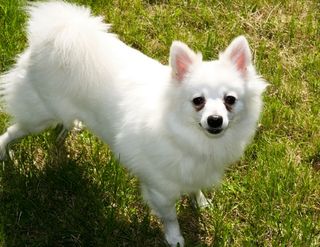Volpino Italiano
This name means little fox and gives you a good idea of what the dog looks like. It is often referred to as an Italian Spitz.
History
The breed’s origins are not known, but it is believed to be a descendant of the European Spitz which dates back to the Bronze Age. It was a favourite of the Italian royals and aristocracy particularly around the areas of Florence and Rome. It was often used to accompany its
owners in their carriages as its alert demeanour meant it would warn of any imminent danger. The Italian artist and sculptor Michelangelo owned a volpino.
After the Second World War its popularity declined. Although an attempt to revive the breed was made in the 1980s, there are now believed to
be only around 2000 left in the world. It is not that well known outside Italy.
Physical Characteristics
It is a small breed with long hair, a ruff of hair around its neck a curly tail with long hair, a cute fox like face with erect ears. It comes in three recognised colours – white, ‘rosso’ – ginger (quite rare), or champagne. It has lovely big, dark liquid eyes you could fall in love with.
Height:
male 27 – 30cm at the shoulder (10 – 12 inches)
female: 25 – 28cm at the shoulder ( 9 – 11 inches)
Weight:
4 – 5 kilos (9 – 11 lbs).
Temperament
The Volpino has a friendly temperament and is easily trained. It’s also good with children and used to be thought of as a ‘lady’s dog’.
It is playful and affectionate and can has quite high energy for a small dog. It gets very attached to its famiy and can bark quite a lot if intruders are seen or anyone it isn’t used to.
Personal Experience
Since coming to Italy we have had two Volpino crosses. The first was Truffles, the red and white dog who we found abandoned and the second, Whisky, who we took in after we heard a local farmer didn’t want him anymore.
Whisky was two years old when we heard he was looking for a home and I remember going to pick him up with Alan and wondering if he would miss his owners. He sat on my knee on the way home and never looked back or showed the slightest concern that he was leaving. He was a lovely, highly intelligent little dog with a wonderful personality and it broke our hearts when he died eight years later.
Volpino Products
If you love your Volpino then tell the world. Have a look at some of these cool gifts and products featuring this rare little dog.
Links:


Pingback: Italian Dog Breeds
Hello,
I have recently acquired a small Dog (bitch) not wanted becouse she got to large?
She was bought as a Pomeranian and clearly she is not maybe a cross?
Ive been talking to people about her to try and find out what breed she could be or crossed with, someone said a spizs then I found the Volpino and the resemblance is outstanding to the point we are thinking of a DNA test… she is the Red-Ginger.
Hi Jan
It’s lovely to own any dog, but if she is a Volpino you are really lucky because they are wonderful. I have had two, both unforgettable.
I had a dog like this; he was the last of Spitz’s when they were still considered a breed. Technically, due to his size (about 20 – 25 pounds) he was a German Spitz. What you probably habe is an Italian Spitz, very rare, especially in ginger colour. She is probably not a direct mix, but the Spitz catagory included the Spitz dogs from Germany, Italym Japan (longest life) & Finland; Th Samoyed, and all Pomeranian types. Now the American Eskimo (which is really not American at all) fall in as a Spitz. All these breeds except for the Italin Spitz and the Finnish Spitz are traditionally white.
The females tend to be nasty – henc the term “bitch”; males not so much so unless atagonized or in a confrontation with a bigger dog, or when defending an owner. All these breed tend to be intelligent, through not credited. They can tend to be social, and good with kids.